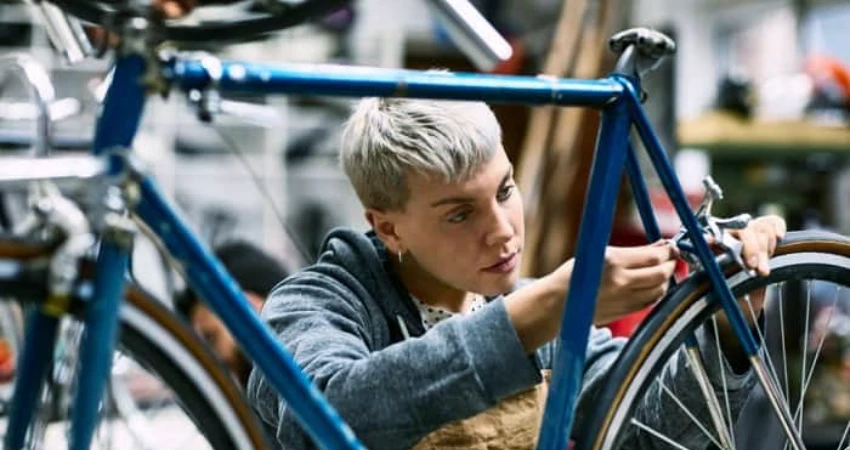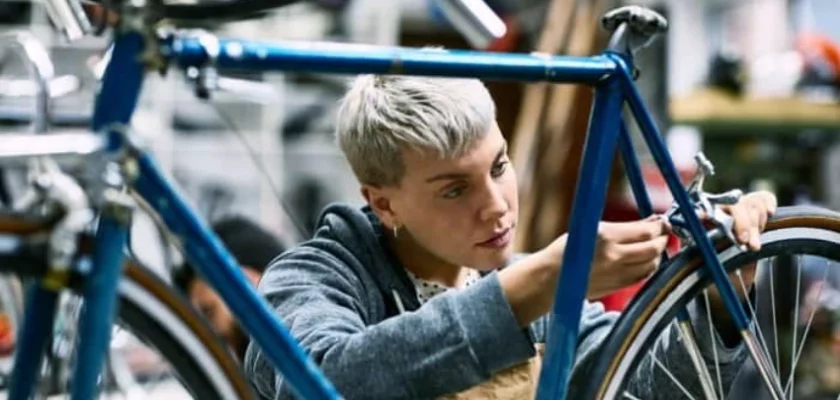Have you ever wanted to give your bike a fresh new look but dreaded the idea of taking it apart? Well, you’re not alone. Many bike enthusiasts find themselves wondering if it’s possible to paint their bikes without undergoing the tedious task of dismantling all the parts. So, can you paint a bike without taking it apart?
The answer is, yes, you can! In this blog article, we’re going to delve into the fascinating world of bike customization and explore the various methods and techniques that allow you to transform the appearance of your beloved two-wheeler without the hassle of disassembly.
From simple spray painting to vinyl wraps, we’ll uncover the secrets to achieving a stunning bike makeover while keeping everything intact. So, let’s dive right in and discover the possibilities of painting a bike without taking it apart!
Can You Paint a Bike Without Taking It Apart?

Painting a bike without disassembly can be a convenient option, especially if you don’t have the technical expertise or tools to remove and reassemble the various components.
The Pros and Cons of Painting a Bike Without Taking it Apart
Like any DIY project, there are advantages and disadvantages to painting a bike without disassembly. Let’s take a closer look at both sides of the coin:
Pros
1. Time-saving: Painting a bike without taking it apart can save you a significant amount of time. Disassembling and reassembling a bike can be a labor-intensive task, especially if you are not familiar with bike mechanics. By skipping this step, you can focus solely on the painting process.
2. Simplicity: Not everyone possesses advanced mechanical skills or has access to specialized tools. Painting a bike without disassembly requires minimal technical expertise, making it accessible to a wider audience.
3. Cost-effective: Taking a bike apart often involves purchasing additional tools or seeking professional assistance. By painting your bike without disassembling it, you can save money on these potential expenses.
Cons
1. Incomplete coverage: Painting a bike without taking it apart can make it challenging to achieve complete coverage. Some areas, such as the inside of the fork or the underside of the frame, may be difficult to access, resulting in uneven paint distribution.
2. Limited color choice: If you choose to paint your bike without disassembly, you may have to work around existing components and accessories. This limitation could restrict your color choices or require extra effort to mask certain parts.
3. Reduced durability: Without disassembling the bike, it can be more challenging to properly prepare the surface for painting. This lack of preparation may lead to a shorter paint lifespan and reduced overall durability.
The Step-by-Step Guide to Painting a Bike Without Taking it Apart
Now that we understand the pros and cons, let’s dive into the step-by-step process of painting a bike without dismantling it. Following these guidelines will help you achieve the best possible results:
1. Preparation
- Start by cleaning the bike thoroughly. Remove any dirt, grease, or grime using a mild detergent and water solution.
- Use sandpaper or a fine-grit sanding block to create a rough surface for better paint adherence. Focus on areas that are easily accessible, such as the frame and fork.
2. Masking
- Use masking tape and plastic sheets to protect any components or areas that you do not want to be painted. This includes the saddle, handlebars, brakes, and drivetrain. Securely cover these parts to prevent overspray or accidental paint application.
3. Priming
- Apply a primer specifically designed for painting metal surfaces to ensure better adhesion and durability. Hold the spray can about 6-8 inches away from the bike and apply an even coat. Allow the primer to dry completely according to the manufacturer’s instructions.
4. Painting
- Choose a high-quality enamel spray paint suitable for metal surfaces. Shake the can vigorously for at least one minute before applying.
- Hold the can at a consistent distance from the bike, typically about 6-8 inches, and apply thin coats of paint. Building up thin layers will result in a smoother finish and reduce the risk of drips or runs.
- Let each coat dry thoroughly before applying the next, following the recommended drying time on the paint can. Multiple thin coats will provide a more durable and even finish.
5. Finishing Touches
- Once you are satisfied with the painted surface, carefully remove the masking tape and plastic sheets. Take your time to avoid any accidental damage to the newly painted areas.
- Inspect the bike for any touch-ups or areas that may need additional coverage. Use a small brush or paint pen to address any imperfections.
Tips for Painting a Bike Without Taking it Apart
To ensure a successful paint job and a fresh-looking bike, consider the following tips:
– Choose the right paint: Look for enamel spray paint specifically designed for metal surfaces. These paints typically provide better durability and weather resistance.
– Use a primer: Applying a primer before painting is crucial for adhesion and longevity. Select a primer that is suitable for metal surfaces and follow the manufacturer’s instructions.
– Work in a well-ventilated area: Spray painting generates fumes that can be harmful if inhaled. It is important to work in a well-ventilated space, such as an open garage or outdoors, to ensure your safety.
– Don’t rush the drying process: Each layer of paint needs adequate time to dry before applying the next coat. Rushing this step can result in an uneven finish or damage to the paint job.
– Consider the weather: Avoid painting your bike on a humid or rainy day, as it can affect the drying process and result in a subpar finish.
– Practice patience: Painting a bike without disassembling it requires attention to detail and patience. Take your time, follow the steps carefully, and you’ll be rewarded with a beautiful end result.
Frequently Asked Questions
1. Is it possible to paint a bike without taking it apart?
Yes, it is possible to paint a bike without taking it apart, but it may affect the quality of the paint job and could result in missed spots or uneven coverage.
2. What are the challenges of painting a bike without disassembling it?
The main challenge is limited access to certain areas, such as the inside of the frame or the backside of components. This can make it difficult to achieve a thorough and professional-looking paint job.
3. Are there any alternative methods to achieve good results without disassembling the bike?
Yes, there are alternative methods like using spray paints or vinyl wraps. These options are easier to apply without disassembling the bike, but they may still require careful preparation and attention to detail for a satisfactory outcome.
4. What are some tips to consider if painting a bike without taking it apart?
Ensure thorough cleaning of the bike’s surface, use masking tape to protect areas not to be painted, apply multiple thin coats for better coverage, and be patient during the drying process for a smooth finish.
5. Can the bike be disassembled partially to make the painting process easier?
Yes, partially disassembling the bike can simplify the painting process and allow better access to hard-to-reach areas. However, it is essential to label and keep track of removed components to ensure easy and correct reassembly.
Final Thoughts
In conclusion, painting a bike without taking it apart is indeed possible and can be a time-saving option for those looking to give their bicycle a fresh new look. By following a few simple steps, such as cleaning and sanding the surface, priming, and applying multiple coats of paint, you can achieve satisfactory results without having to disassemble the entire bike.
However, it is important to note that painting a bike without disassembling it does have its limitations. The final result may not be as seamless and professional-looking as a paint job that involves taking the bike apart. Certain parts, such as brakes, gears, and chains, may be more difficult to paint, and there is a higher risk of overspray or uneven coverage.
Ultimately, whether or not to paint a bike without taking it apart depends on personal preference, time constraints, and the desired outcome. While it is possible to achieve a satisfactory result, conducting a full disassembly and reassembly is still the recommended approach for a flawless and long-lasting paint job.

